Example 2.
Solve the equation x
4 - 8x + 63 = 0.
Solution.
Let's try to factor the left side of the equation into 2 quadratic factors: x
4 - 8x + 63 = (x
2 + bx + c)(x
2 + dx + e).
We will find the unknown values b, c, d, e using the method of undetermined coefficients. We multiply two brackets and equate the coefficients at the same powers of x, we get the following system of equations:

Let us express the unknown d through b and substitute it into the equations of the system:
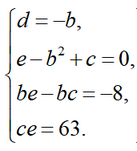
Hence
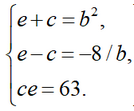
Adding and subtracting the first two equations of the system, we obtain expressions for e and c through b:

Finally, substituting the expressions for e and c into the third equation, we obtain an equation for b
b6 - 63*4*b2 - 64 = 0.
By simple substitution we see that b=4 is the root of the equation. Therefore, d = -4, e = 7, c = 9. Thus, we obtain the factorization
x4 - 8x + 63 =(x2 + 4x + 9)(x2 - 4x + 7).
By equating each bracket to zero and solving the resulting quadratic equations, we find solutions to the original equation:
x1,2 = -2±i√5; x3,4 = 2±i√3.
Answer: -2-i√5, -2+i√5, 2-i√3, 2+i√3.
Another example of the application of the method of undetermined coefficients.
Example 3. Solve the equation x
4 + 3x
3 - x
2 + 2x + 2 = 0.
Solution.
Let's try to factor the left side of the equation into 2 quadratic factors: x
4 +3x
3 - x
2 + 2x + 2 = (x
2 + bx + c)(x
2 + dx + e).
We multiply two brackets and equate the coefficients at the same powers of x, we get the following system of equations:
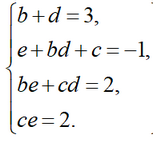
Since ce=2, then if we assume that c and e are integers, then there are 2 possible options c=±2, since the option c=±1 simply changes the order of the quadratic factors. It is easy to verify that the solution of the system exists only when e=2, then c=1. Substituting these values into the system, we obtain
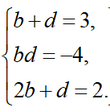
Hence b = -1, d = 4. Thus, we obtain the factorization
x4 +3x3 - x2 + 2x + 2 = (x2 - x + 1)(x2 + 4x + 2).
By equating each bracket to zero and solving the resulting quadratic equations, we find solutions to the original equation:
x1,2 = (1±i√3)/2; x3,4 = -2±√2.
Answer: -2-√2, -2+√2, (1-i√3)/2, (1+i√3)/2.
Example 4.
Solve the equation x
4 - b = 0, where b≥0.
Solution.
Let's factor the left side of the equation using the difference of squares formula:
(x2 -√b)(x2 +√b) = 0.
Equating each bracket to zero, we get x
2 = √b or x
2 = √-b.
Hence
 Answer:
Answer:  Example 5.
Example 5.
Solve the equation x
4 + b = 0, where b≥0.
Solution.
Let's factor the left side of the equation using the difference of squares formula:
(x2 -√(-b))(x2 +√(-b)) = 0 or (x2 -i√b)(x2 +i√b) = 0.
Equating each bracket to zero, we get
x2 = i√b or x2 = -i√b.
As is known, the second root of a complex number
z,
z = r *(cosφ + isinφ)
has 2 complex values √z=z
k , k=0,1,
where

Since

for the square roots of i√b and -i√b we obtain the expressions

Hence taking into account that cos(π/4)=√2/2, sin(π/4)=√2/2, cos(3π/4)=-√2/2, sin(3π/4)=√2/2, we obtain the final expressions for the roots of the original equation:
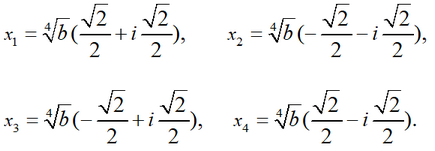 Answer:
Answer:















